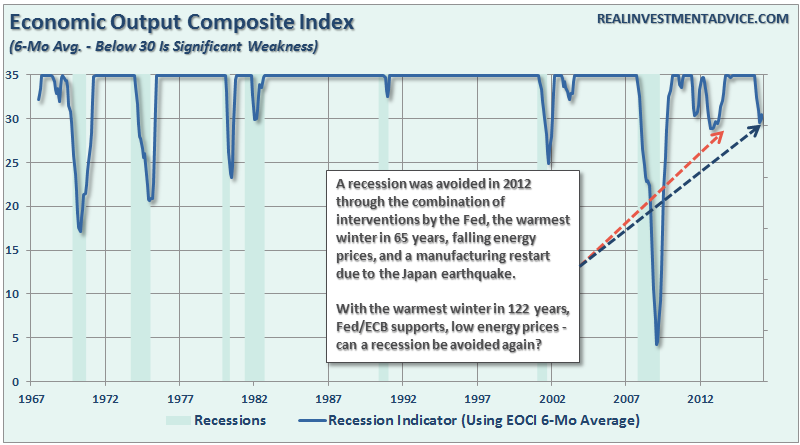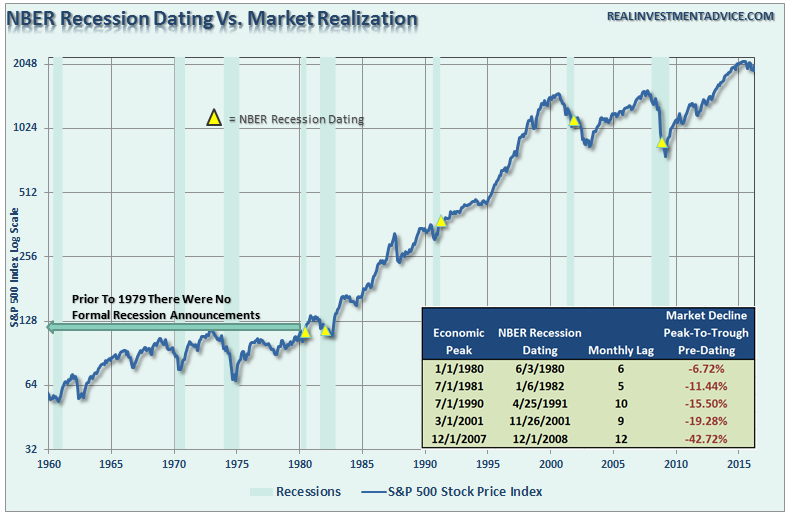Earnings Are Beating Estimates Like Crazy
In a not-so-surprising outcome, the number of companies beating earnings estimates currently is above the 12-quarter average. Via Zacks Research:
While growth remains problematic, actual results are turning out to be less bad relative to the low levels to which estimates had fallen ahead of this reporting cycle. More companies are coming out with positive surprises for both earnings as well as revenues.
Total earnings for the 209 S&P 500 members that have reported results are down -5.5% from the same period last year on -1.6% lower revenues, with 75.6% beating EPS estimates and 56% coming ahead of top-line expectations.
So, this is all good news and a reason to buy stocks, right? Not so fast.
The problem, as shown in the chart above, is that the pace of growth in earnings is far weaker than previous averages. Furthermore, while Wall Street will point to the “beat rate” as a reason why the current “bull market” is still intact, it has been a function of excessively low expectations.
The problem is that expectations for the second half of the year are still overly optimistic.
Many see the Q1 earnings season as the inflection point for corporate earnings, with the growth picture starting to improve from Q2 onwards and turning positive in the back half of the year. The relative more numerous positive surprises and the fewer negative revisions to current-period estimates would support that view.
For profits to improve to such a degree in the second half of the year, such would suggest a resumption of economic growth both domestically and internationally. However, there is scant evidence currently that such is going to be the case given the ongoing drive to suppress interest rates and flood the financial system with liquidity.
As shown by the Economic Output Composite Index (Chasing Return But Still In Cash), economic growth is currently at levels more normally associated with recessions. The only previous anomaly was in 2012 as the combination of Central Bank interventions, a Japanese earthquake/tsunami, a warm winter and falling energy prices all collided to drag forward consumption.
(The indicator uses a 6-month average to smooth out the month-to-month volatility caused by seasonal adjustment anomalies as we are currently witnessing.)
Will the recent exceptionally warm winter, low energy prices, and Central Bank interventions once again be enough to stave off further economic weakness? We will have to wait and see.
Secondly, stock buybacks have been a major support of earnings reports over the last several quarters.
As top line revenue growth has remained mired in a slow growth state, along with the economy, bottom line earnings per share have skyrocketed due to ongoing cost-cutting, wage suppression and share buybacks. Q1 is currently estimated to show the largest differential in Operating EPS, as compared non-buyback adjusted Operating EPS, of $1.08.
What is interesting is when we take a look at the estimated Operating EPS for Q1 currently and compare that to the estimates for Q1 of 2016 in January of this year. Currently, Operating EPS for Q1 is expected to be $25.35 when in January it was estimated to be $28.05. If we back out $2.70 over-estimation error, the current beat rate for earnings is actually ZERO.
But, of course, that takes all the fun out of the “beat the earnings estimates” game, doesn’t it?
Warning In Today’s GDP
Contributing Editor Michael Lebowitz, via 720 Global Research, penned the following Thursday morning:
In today’s GDP release the Bureau of Economic Analysis (BEA) reported 0.50 % annualized economic growth, a sharp departure from the 1.40% annualized growth of the prior quarter.
Economic growth is now running below a 1.00% annualized rate for the last two-quarters and has been by and large trending lower for the last two years as graphed below.
Economists consider this quarter an anomaly as judged by their forecasts for a rebound in the second quarter. The current consensus projection for the second quarter ending June 30, 2016, is 2.50%. Despite a secular trend of slowing domestic economic growth and global economic weakness, few economists are predicting a recession this year. Then again, few have ever correctly forecast a recession. The graph below highlights the slowing secular trend in GDP growth and the series of cycles through which the U.S. economy tends to move. Note that five of the last seven economic cycles have progressively peaked at lower levels. If the current cycle peaked in mid-2015 (labeled “peak?”), a multi-year decline in GDP growth is likely. The average decline in economic growth from peak to trough for the seven cycles has been -4.3%, with -3.0% being the smallest decline. A 3.0% decrease from the current level of 2.3%, implies that the U.S. economy will have a three-year period averaging -0.7% growth.
If economists are correct and economic growth in the second quarter remains true to forecasts, the economy will avoid a recession in the first half of the year. That said, we must consider that while economists foresee a pickup in economic activity, relying on their forecasts is dangerous. On February 14, 2016, the Atlanta Federal Reserve was forecasting first-quarter economic growth of 2.7%, and a consensus of economists expected 2.1% growth. Based on today’s GDP data, those forecasts were grossly off the mark, leaving one to question the integrity of second-quarter forecasts.
Michael is correct. Importantly, however, will be the annual backward revisions to the data which will likely show that 2015 and 2016 economic growth was substantially weaker than current reports currently suggest. This was what was seen when 2012 growth rates were marked sharply downward as well. Of course, there is one main driver of recessions that we must now review.
Recessions Are Driven By The Market
As I penned previously:
Recessions don’t cause bear markets, bear markets cause recessions.
George Soros once discussed the idea of “reflexivity” suggesting that:
Reflexivity sets up a feedback loop between market valuations and the so-called fundamentals which are being valued. The feedback can be either positive or negative. Negative feedback brings market prices and the underlying reality closer together. In other words, negative feedback is self-correcting. It can go on forever, and if the underlying reality remains unchanged, it may eventually lead to an equilibrium in which market prices accurately reflect the fundamentals.
By contrast, a positive feedback is self-reinforcing. It cannot go on forever because eventually, market prices would become so far removed from reality that market participants would have to recognize them as unrealistic.When that tipping point is reached, the process becomes self-reinforcing in the opposite direction. That is how financial markets produce boom-bust phenomena or bubbles. Bubbles are not the only manifestations of reflexivity, but they are the most spectacular.
This idea of reflexivity is important in understanding the relationship between market psychology and the ultimate outcome of the markets themselves. While the vast majority of the media and analysts continue to assert the markets are fine because there is currently “no signs of recession,” it ignores the impact of the psychology of the participants.
Bear markets are a result of the switch of market psychology from “greed” to “fear” driven by an event that leads to a broad market “selling panic” that triggers a negative feedback loop in the market. (reflexivity)
Recessions are coincident with market declines ONLY IN HINDSIGHT. The reason is due to the annual revisions to past economic data that only reveal the start and end of the recession after the fact. (The chart below shows this effect.)
Jeffrey Gundlach, head of Doubleline, recently made the same observation, stating:
We will be on watch for that [a recession] in the coming months. But it doesn’t really matter. Recessions don’t drive financial markets. It’s the other way around. People are so focused on this «recession-yes-or-no-question». What really matters is that we are in a low nominal growth environment and global growth keeps getting marked down. It is going to be slower in 2016 than in 2015.
Here is the important point.
In a number of cases over the past century, a bear market in U.S. stocks was well underway long before a recession had taken hold of the U.S. economy. If you are waiting for the confirmation of a recession before taking actions to protect your investment portfolio, it will likely be far too late.
With valuations pushing extreme levels, economic growth extremely weak and markets now grossly exuberant based solely on “future hopes,” such has been a toxic brew that has left investors wondering what went wrong.
As Gundlach summed up:
In the financial markets, 80% of the time it’s a coin flip. But the other 20% of the time you have very high confidence and it’s not a coin flip. For instance, I don’t think the stock market is a coin flip. Especially in the United States stocks are very expensive, particularly low volatility stocks.
The riskiest things are now stocks and other investments perceived to be safe. One of the most popular categories in US investing are low volatility stock funds. But there is no such thing! If you think that a stock like Johnson & Johnson (NYSE:JNJ) can’t go down, you’re wrong. And if people own funds that invest in stocks which they think are immune from decline and they start to decline, all hell breaks loose.
Just some things to think about.







